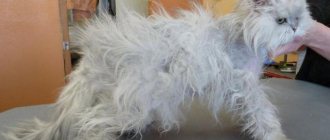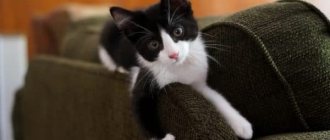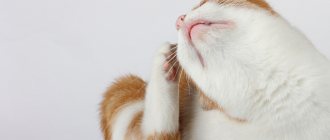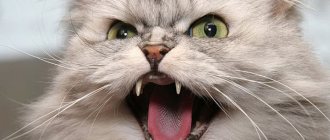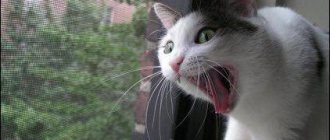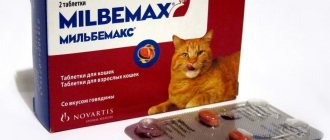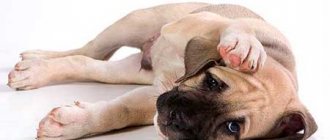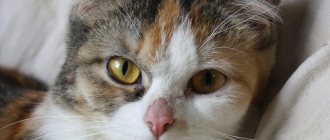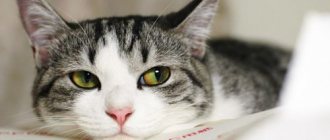What are mats?
The fur of cats, especially long-haired breeds, requires careful care. With a lack of hygiene, poor nutrition and other mistakes when keeping pets, their fur begins to deteriorate. This affects not only appearance, but also health.
Older pets cannot provide themselves with the same careful care as younger pets. The wool begins to get tangled, matted, and tangles form. However, young age is not a guarantee that lumps will not appear.
Prevention of tangle formation
It is not difficult to prevent the appearance of tangles:
- Brush every day or at least 3 times a week.
- Use special shampoos for long-haired breeds, dry shampoos and antistatic agents.
- Give vitamins for skin and coat.
- Use a hairdryer to dry after swimming.
To eliminate problems with an adult animal, combing is taught from an early age.
Begin combing using a brush with sparse metal teeth and preferably with rounded ends. Plastic combs are not suitable as they generate static electricity. It is better not to use a slicker on breeds with a thick undercoat. It injures fine hairs that are difficult to recover.
It is important to comb along the entire length right down to the skin. Combing begins from the head, gradually moving towards the tail, ending with the paws
The tail should not be combed unless necessary. There are very delicate hairs that are easily injured.
The second stage is combing out the fallen hairs with a fine-tooth comb.
Finally, remove hairs with a special mitten or mitten. It is not recommended to use combs with synthetic bristles. Synthetics cause hair to become electrified and brittle.
Anti-tangle shampoos
It is unacceptable to wash a cat with human shampoo. Cats do not like frequent bathing. But it is necessary to arrange bathing periodically.
The procedures must be carried out taking into account the following recommendations:
- bathe if necessary, no more than once a month (main baths during molting periods - in spring and autumn, additional ones - when the coat is heavily soiled);
- use pet shampoos and conditioners sold in veterinary stores;
- do not crumple the wet fur of a bathing pet, but gently stroke it from the head to the rump;
- after bathing, wipe in the direction of hair growth;
- Be sure to dry and comb the washed wool.
Health monitoring
It is recommended to regularly examine the cat at home, for example while brushing or playing, and to have a medical examination with a veterinarian 1–2 times a year. At the first signs of illness or the presence of alarming symptoms, the animal should be taken to the veterinarian as soon as possible.
Balanced diet
Proper nutrition, taking into account the daily need for nutrients, vitamins and minerals, taking, if necessary and only on the recommendation of a doctor, complex vitamin-mineral preparations, fatty acid complexes, and having clean water available at all times are some of the main conditions that have a beneficial effect on the beauty of the coat. pet
Careful proper care
It includes combing and periodic washing using special shampoos selected taking into account the animal’s coat type, as well as additional cosmetics to make combing easier.
In addition, it is important to prevent the air in the room where the pet lives from drying out.
For daily combing of fluffy cats, you will need combs with rare, non-sharp teeth and special brushes. It is better to carry out the procedure in several stages so as not to cause fatigue and irritation to the animal.
When combing, special attention is paid to the armpits, belly, tail, and areas behind the ears. It is necessary to accustom your cat to such manipulations from an early age.
In addition, daily brushing helps not only maintain the aesthetic appearance of the coat, but also strengthens the emotional connection between the owner and the cat, allowing you to show your pet your love and care.
Causes
If pets are healthy and can take care of their hygiene, they usually do not develop tangles. However, there are cat breeds with fluffy fur and thick undercoat that are prone to ball formation. These include Persians, British, Turkish Angora and others.
Not all long-haired breeds suffer from mats. For example, Siberian cats and Maine Coons rarely develop lumps. Mainly in places of thick and wavy undercoat (on the “collar”, “pants”).
Mats on wool appear for the following reasons:
- the pet is rarely or not brushed at all;
- during the molting period, the animal’s old fur is not combed out;
- the pet is sick;
- the cat is washed with an incorrectly selected shampoo; when soaping, the fur becomes very crumpled, which is why dense clumps are formed;
- the cat is lazy and fat, obese;
- the pet does not eat rationally, which is why it may develop vitamin deficiency (the fur becomes very loose and the risk of lumps forming increases);
- sticky substances (for example, jam, honey, paint, etc.) have come into contact with the fur;
- pathological conditions develop: oncology, parasites, dermatitis, endocrine disorders.
If a pet develops tangles, the owner is to blame. This means he did not take good care of the animal.
Preventing problems with your cat's coat
Preventive measures for any fluffy long-haired cats, in particular Maine Coons, Siberians, Angoras and Persians, include the following simple rules:
- Brush the animal at least once a week (Persians are scratched more often, sometimes every day).
- To untangle the hair knot, use a special spray.
- When combing your cat's coat, use a comb with round toothed ends so as not to injure the cat.
- When shedding, be sure to remove loose hair using a slicker. At other times, this tool should not be used.
- In extreme heat at the dacha or at home, a very “shaggy” cat should be trimmed. This will not only prevent tangles, but also protect it from overheating and heat stroke.
- Sometimes, to stop the formation of mats, you need to change the cat's food or add a little more fats and vitamins.
A good owner monitors the health of his pet and its appearance. Small fur seals need to be eliminated immediately, then there will be no need for labor-intensive removal of tangles. Simple brushing takes no more than five minutes a day, brings a lot of pleasure to the animal when done correctly and protects it from painful formations in its luxurious fluffy fur.
https://vplate.ru/koshki/koltuny/https://kot-pes.com/koltuny-u-koshki-prichiny/https://kotmurka.ru/uhod/ubrat-koltuny-kota-doma.html
Why are they dangerous?
The appearance of matted fur spoils the appearance of the animal. This is a huge disadvantage for a breeder of purebred cats. In addition, petting a pet with mats is unpleasant.
However, these are not the worst consequences. Mats can provoke the development of various diseases. Pathogenic microorganisms begin to multiply in matted wool. When a pet licks itself, they enter the body and continue their synthesis there.
Fleas, lice, ticks and other parasites take root well in tangles. The skin under the lumps becomes rotten, dermatological problems arise that are difficult to treat. In addition, the cat will try to independently remove matted fur with its claws, and in the process may cause wounds to itself. Such damage will take a long time to heal.
A balanced diet is the key to proper coat growth
Cats are predators, albeit small ones.
They need a certain amount of animal protein every day. Protein is the main source of energy necessary for both the active movement of the pet and the improvement of the coat.
The diet should contain vitamin A and arachidonic acid, without which the hairs become fragile and the hair loses its elasticity and shine.
A deficiency of microelements leads to a malfunction of organs and systems and causes the formation of tangles.
It is difficult to choose a balanced diet for a pet using products from the owner’s table.
In order for the fur to grow normally, be healthy and not roll into shreds, the cat must eat special food, the choice of which must take into account the animal’s age and status - for kittens or adult pets, pregnant and lactating.
For cats over 7 years of age, it is advisable to find a food formulated for older animals.
Removal methods
Tangles are removed from wool in the following ways:
- If the lumps are small, you can comb them out. The pet should be placed on its side and stroked. This is necessary so that he calms down and does not break out. First, comb the sides and back, neck and chest, forelimbs, tail. It is more difficult to get rid of tangles on the stomach and hind legs. Most likely the animal will bite.
- Large clumps are recommended to be cut lengthwise and then combed.
- If there are a lot of tangles, it is completely impossible to comb them out, then the tangled hair will have to be cut to the ground. You need to be very careful: a cat’s skin is thin and can be easily damaged. Clumps can be removed with scissors, people clippers or hair clippers. The receding hairline will heal after a few months.
- At the pet store you can purchase a special device called a tangle cutter. This is a comb with blunt ends, blades between the teeth.
- You can take your cat to a veterinarian or pet groomer. There your pet will be trimmed at an affordable cost.
- To deal with long unnecessary hair, there is a special comb - a furminator. Not only will it help get rid of clumps, but it will also be an indispensable tool for daily combing.
Why do tangles form?
Long-haired cats definitely need timely care. If you do not monitor the condition of the animal's fur, very soon the pet will become covered with tangles. Most often they appear in places of bends and friction - behind the ears, armpits, on the stomach, in the groin, and in advanced cases - on the sides. Sometimes mats can appear due to improper care of the animal.
When washing, you need to gently stroke the fur, and not lather or ruffle it. The fact is that such wool is very difficult to comb, so washing should be delicate. During periods when the cat sheds old fur, the animal needs to be combed daily.
If you don't do this, you won't be able to avoid tangles. Sometimes hair may fall out excessively due to poor nutrition. Long-haired cats require a balanced diet, with a full range of vitamins and minerals. If your cat eats dry food, do not forget to supplement its diet with special vitamin complexes. If mats appear suddenly, despite careful care of the animal, the condition and hair loss may indicate an illness in the cat. At the same time, the coat often becomes greasy and dull.
In addition to the fact that tangles look terribly unaesthetic, they are also dangerous for the animal. Firstly, in the hot season, mats disrupt normal thermoregulation - the cat can simply overheat, and as a result, traces of dermatitis appear on the skin. The second reason why you need to get rid of tangles as soon as possible is that they are a breeding ground for bacteria. Not only microbes and viruses can settle inside these hairballs, but also larger representatives of insects - fleas and ticks. In addition, tangles really bother the cat herself, bringing her a lot of inconvenience. Often, animals try to get rid of hairballs on their own by tearing them out, leaving injuries on the skin.
All this suggests that tangles should not be allowed to appear on the animal’s fur. If this does happen, you need to get rid of this unpleasant problem as soon as possible.
Rules for removing mats in cats
Recommendations for removing mats:
- The process of eliminating lumps is long. Most likely, your pet will not like it. The pet will not give in and will start fighting. Therefore, it is better to comb out tangles together: one person holds the cat, the other combs it. If the animal is very nervous, then it is better not to traumatize its psyche and get rid of the matted fur not at once, but several times.
- Only areas with long hair are clipped. It is better not to touch the paws and head. It's okay if your pet looks like a lion. The fur will grow back in a couple of months.
- Until the mats are removed, washing the animal is prohibited. After water, lumps are more difficult to comb out.
- After combing, treat the pet's fur with an antistatic spray. The product will detangle your hair and prevent further formation of tangles.
How to help your furry pet
Mats are not classified as a disease. But they can become not only a consequence of stress, but also its cause.
The more pellets there are on a cat’s body, the more difficult it is for her to get rid of them on her own. The owner must take care of the condition of the cover.
We save from tangles
| Methods | Peculiarities |
| Combing | It must be regular. The longer the hair, the more often the procedure is performed. To do this, you will need a special brush or combing glove or a comb with mild, wide-toothed teeth. |
| Unraveling | Fresh clumps of wool can be sorted out by hand by carefully separating the hairs. Then the animal is combed, paying special attention to problem areas. |
| Cutting | It is better to deal with neglected tangles with scissors. To begin with, you will have to separate the clump with your hands so as not to injure your pet’s skin. The procedure is completed by combing out |
| Colt cutter | This device, which is a hybrid of scissors and a comb, helps speed up the procedure and makes it safer |
When the owner’s efforts do not produce a positive result, it is recommended to contact specialists involved in grooming animals. In the salon, in addition to a haircut, your pet will also be provided with other services (they will tidy up their claws and treat their skin).


